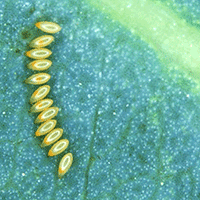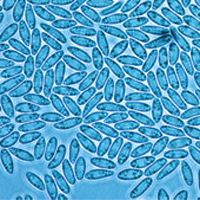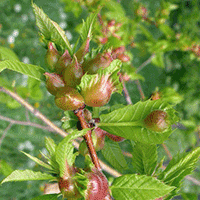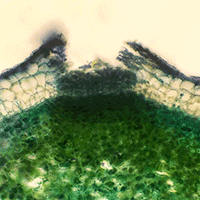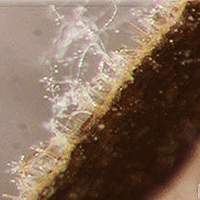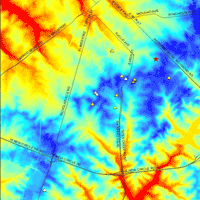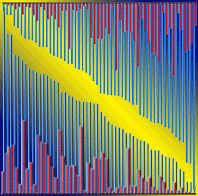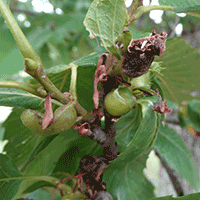
Gnomoniopsis castaneae associated with Dryocosmus kuriphilus galls in chestnut stands in Sardinia (Italy)
Salvatore Seddaiu (1), Anna Cerboneschi (1), Clizia Sechi (1), Antonietta Mello (2)
iForest - Biogeosciences and Forestry, Volume 10, Issue 2, Pages 440-445 (2017)
doi: https://doi.org/10.3832/ifor2064-009
Published: Mar 24, 2017 - Copyright © 2017 SISEF
Research Articles
Abstract
Invasive fungal pathogens and pests of sweet chestnut (Castanea sativa Mill.) forests drastically reduce their productivity. The recently described Gnomoniopsis castaneae is one of the main agents involved in the epidemic of brown rot of chestnut nuts worldwide. In 2014, during an investigation aimed at evaluating the health status of chestnut forests in Sardinia, a high incidence of necrotic galls induced by the Asian gall wasp Dryocosmus kuriphilus Yasumatsu (Hymenoptera, Cynipidae) was observed. Several fungal isolates were consistently isolated from necrotic gall tissues. Based on their morphological characters and analyses of both the ITS and EF1-α-coding gene sequences, all isolates were identified as Gnomoniopsis castaneae.
Keywords
Galls Necrosis, Brown Nut Rot, Invasive Pests, Forest Pathogens
Authors’ Info
Authors’ address
Anna Cerboneschi
Clizia Sechi
Cork and Silviculture Research Service, Agris Sardegna, v. Limbara 9, I-07029 Tempio Pausania (Italy)
Institute for Sustainable Plant Protection, SS Torino - CNR, v.le Mattioli 25, I-10125 Torino (Italy)
Corresponding author
Paper Info
Citation
Seddaiu S, Cerboneschi A, Sechi C, Mello A (2017). Gnomoniopsis castaneae associated with Dryocosmus kuriphilus galls in chestnut stands in Sardinia (Italy). iForest 10: 440-445. - doi: 10.3832/ifor2064-009
Academic Editor
Alberto Santini
Paper history
Received: Mar 21, 2016
Accepted: Nov 27, 2016
First online: Mar 24, 2017
Publication Date: Apr 30, 2017
Publication Time: 3.90 months
Copyright Information
© SISEF - The Italian Society of Silviculture and Forest Ecology 2017
Open Access
This article is distributed under the terms of the Creative Commons Attribution-Non Commercial 4.0 International (https://creativecommons.org/licenses/by-nc/4.0/), which permits unrestricted use, distribution, and reproduction in any medium, provided you give appropriate credit to the original author(s) and the source, provide a link to the Creative Commons license, and indicate if changes were made.
Web Metrics
Breakdown by View Type
Article Usage
Total Article Views: 51626
(from publication date up to now)
Breakdown by View Type
HTML Page Views: 41984
Abstract Page Views: 4047
PDF Downloads: 3940
Citation/Reference Downloads: 183
XML Downloads: 1472
Web Metrics
Days since publication: 3196
Overall contacts: 51626
Avg. contacts per week: 113.07
Citation Metrics
Article Citations
Article citations are based on data periodically collected from the Clarivate Web of Science web site
(last update: Mar 2025)
Total number of cites (since 2017): 17
Average cites per year: 1.89
Publication Metrics
by Dimensions ©
Articles citing this article
List of the papers citing this article based on CrossRef Cited-by.
References
Pericoloso insetto esotico per il castagno europeo [A dangerous exotic insect threatening European chestnut]. Informatore Agrario 37: 59-61. [in Italian]
Gscholar
Alberi e arbusti spontanei della Sardegna [Trees and shrubs spontaneous of Sardinia]. Carlo Delfino Editore, Sassari, Italy, pp. 480. [in Italian]
Gscholar
Inventario Nazionale delle Foreste e dei Serbatoi Forestali di Carbonio [National Inventory of Forests and Forest Carbon Sinks]. Ministero delle Politiche Agricole Alimentari e Forestali, Ispettorato Generale - Corpo Forestale dello Stato, Rome, Italy, Consiglio per la Ricerca e Sperimentazione in Agricoltura Unità di ricerca per il Monitoraggio e la Pianificazione Forestale (CRA-MPF), Trento, Italy, Web site, [in Italian]
Online | Gscholar
Widespread Phytophthora infestations in European nurseries put forest, semi-natural and horticultural ecosystems at high risk of Phytophthora diseases. Forest Pathology 46: 134-163.
CrossRef | Gscholar
Phylogeny, morphology and pathogenicity of Botryosphaeriaceae, Diatrypaceae and Gnomoniaceae associated with branch diseases of hazelnut in Sardinia (Italy). European Journal of Plant Pathology 146: 259-279.
CrossRef | Gscholar
Dryocosmus kuriphilus (Hymenoptera Cynipidae) in Sardegna. [Dryocosmus kuriphilus (Hymenoptera Cynipidae) in Sardinia]”. In: Proceedings of the “XXIV Congresso Italiano di Entomologia”. Orosei (Sardinia, Italy) 9-14 Jun 2014, pp. 132. [in Italian]
Gscholar
Il cinipide del castagno in Sardegna: una nuova preoccupante presenza nella Barbagia di Belvì. [The chestnut gall wasp in Sardinia: a new disturbing presence in Barbagia di Belvì (Sardinia, Italy)]. Notiziario sulla protezione delle piante 21: 203-206. [in Italian]
Gscholar
Biogeographical patterns and determinants of invasion by forest pathogens in Europe. New Phytologist 197 (1): 238-250.
CrossRef | Gscholar
On the fungal species Gnomoniopsis castaneae (“castanea”) and its synonym G. smithogilvyi. Journal of Plant Pathology 98: 189-190.
Gscholar
New notes on the biology of the chestnut fungus Gnomoniopsis sp. and its possible use as a biocontrol agent of oriental chestnut gall wasp. Acta Horticulturae (ISHS) 1019: 235-238.
CrossRef | Gscholar
Amplification and direct sequencing of fungal ribosomal DNA for phylogenetics. In: “PCR Protocols: a guide to methods and applications” (Innis MA, Gelfand DH, Sninsky JJ, White TJ eds). Academic Press, San Diego, CA, USA, pp. 315-322.
Gscholar


